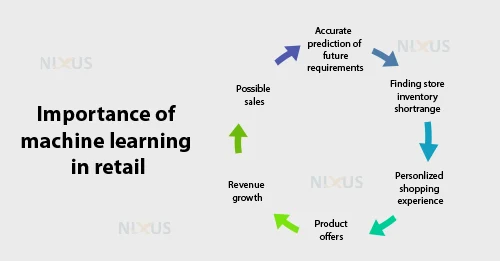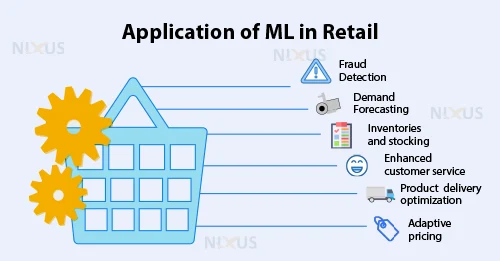Machine Learning in Retail
The development of machine learning (ML), with its potential to increase an organization’s bottom line, has substantially benefited the retail sector. In the retail industry, machine learning is deployed to automate and improve activities. It aids in ensuring accuracy and consistency in retail processes.
Every business aspires to boost revenue and strengthen client relationships. Machine learning has aided in making it possible to stand out from the competitors. Every industry can benefit from machine learning, and the retail sector is no different.
Retailers can more accurately evaluate and forecast consumer behaviour by using machine learning. After all, modern customers demand the greatest possible purchasing convenience and a variety of shopping options. Although customer tastes are always changing, machine learning in retail assists in foreseeing and adapting to these changes quickly. Planning for the best possible sales, inventories, and procurement decisions can also be greatly aided by machine learning.
Importance of Machine Learning in Retail
Machine learning allows computer systems to analyze data and learn from it with little to no assistance from humans. ML model for retailers might swiftly examine and transform complex data into useful insights that could be used for:
- Accurate prediction of future requirements.
- Finding store inventory shortages.
- Set the best prices to promote sales.
- Analyzing text and images from bills, packing lists, invoices, etc.
- Employing chatbots and virtual assistants to analyze customer interactions.
- Enhancing the uniqueness of product offers.
- Assortment planning to manage inventory and supply chain.
- A large-scale application of retail analytics to comprehend annual growth.
- Analysis of the customer model reveals invalid or fraudulent requests.
- Personalized shopping experience.
Applications of Machine Learning in Retail
Many companies are utilizing machine learning to improve the customer experience and increase sales. Let’s check some applications of ML in retail.
1. Inventories and stocking
The capacity to quickly and automatically simplify the management of inventory and stock processes is one of the essential components of operating a successful business. By segmenting these characteristics based on things like the season of the year, the day of the week, and activity in a specific store, ML is giving retailers the option to buy online as well as offline data to estimate inventory requirements in real-time. A buying manager may use this data to build a daily dashboard of suggested orders. In the near future, machine vision might also be employed, like cameras that can instantly determine how many of a given product are present throughout the entire store.
2. ML for Demand Prediction
Demand forecasting or prediction can have a huge impact on how you price, market, and sell your items. For instance, ML engineers can forecast the anticipated sales volumes for a product (such as a certain style of shoes) in the future using regression and historical techniques like time series. Analyzing customers, prices, as well as competitors helps retailers make accurate pricing decisions. It is feasible to predict future inventory needs, ensure the availability of in-demand commodities, and determine prices accurately using logistical and storage data.
3. ML for Enhanced Customer Services
Security measures, enhanced delivery, pricing optimization, and personalized offers are some advantages of machine learning. Customer convenience is improved with chatbots and virtual changing rooms. It’s all about providing excellent customer service, which is getting better.
Customers favour businesses that appreciate their time and offer quick responses and effective solutions. Customers easily receive pertinent solutions more quickly and better product recommendations with the use of machine learning. Customers won’t experience impersonal service anymore and will be able to speak with the appropriate department without difficulty.
4. ML for Delivery Optimization
Product delivery is another area of logistics that may be improved by machine learning. The quickest delivery routes can readily be determined by ML-powered systems using traffic and weather information gathered by networks of IoT sensors and cameras. Instead, by analyzing user data, they might suggest appropriate delivery strategies to better fulfil customers’ requirements.
But the high point of this strategy is Amazon’s probable ML-based predictive shipping technology, which enables forecasting future shipments based on customers’ shopping patterns, moving goods to a nearer warehouse, and being able to ship them more quickly and affordably while the actual order has been placed.
5. ML for Adaptive Pricing
Dynamic pricing, which entails, as the name implies, dynamic modifications to the price of items based on changing conditions, is one of the strategies that has profited the most from the implementation of ML algorithms.
Not just advertisements, product recommendations are also dynamically altering as a result of machine learning. Currently, the majority of online shops and e-commerce platforms often change their prices in response to changes in supply and demand of products, promotions and pricing tactics of rivals, larger sales patterns, and other factors.
6. ML for Self-Driving Automobiles
Humans still become tired and are unable to drive continuously despite the best efforts of route optimization. Robots, on the other hand, can work continuously without the need for a break. This is the rationale for the use of self-driving automobiles in logistics and retail that are computer vision and machine learning enabled.
This application of ML and computer vision for the delivery of products is yet far from being mastered and widely used. But businesses such as Kroger and Amazon are placing their faith in this technology, and soon, we may be dependent on self-driving automobiles to expedite the delivery of goods.
7. ML for Fraud Detection
The fear of products disappearing off the shelves is not the only danger to both retailers and customers, especially in a world where complicated socioeconomic processes are driving us towards full digitization.
Thieves are perhaps more likely to steal credit card money than items off a shelf when it applies to retailers and e-commerce online platforms. Since ML algorithms are created to recognise underlying patterns, they may also spot any occurrence deviating from the normal, such as aberrant transaction frequency or inconsistent account information, and label it as unusual/suspicious for more investigation.
8. ML for Revenue Boosting
When evaluating the viability of machine learning use cases, the revenue aspect of many companies is an excellent place to begin, given the type of data that is generally accessible from sales operations. There are numerous chances to employ machine learning for significant outcomes for sales operations, leaders and managers who wish to intelligently use the data to increase top-line growth and decrease their sales-related costs.
9. ML for Video analysis
Automatic object detection, classification, and tracking are made possible by video analytics. Real-time video analysis creates metadata, which are descriptors of the events captured on video. In addition, people, automobiles, and other things can be found and followed using video analytics. To track, examine, and manage a lot of video footage, it employs advanced ML algorithms. Making better decisions may be aided by this technique of digitally processing video inputs and turning them into meaningful data.
10. ML for Visual recognition
The goal of the ML discipline of Visual recognition is to make it possible for computers to comprehend and interpret visual data similarly to how humans do. To analyze photos and videos and make judgements based on the information they contain, this technology is applied in a variety of applications. Visual Recognition is used in a variety of ways in the retail sector. It is helpful as it is used in stores for object detection and recognition. This makes it easier for businesses to monitor inventory levels, identify when products are running low, and automate the restocking process.
Conclusion
Given the aforementioned advantages, it is clear that ML adoption can have a significant positive impact on retail. ML has a lot to offer in addition to boosting revenue, fostering client loyalty, and providing excellent customer service.

